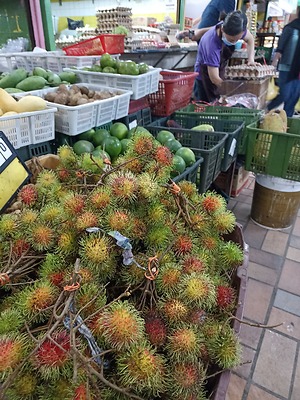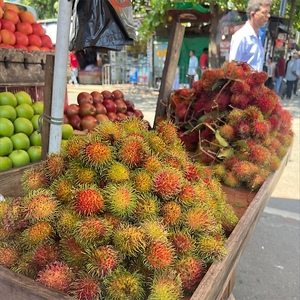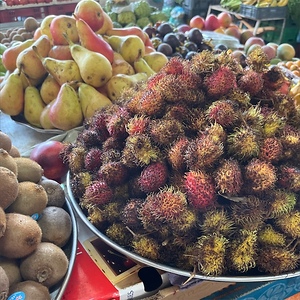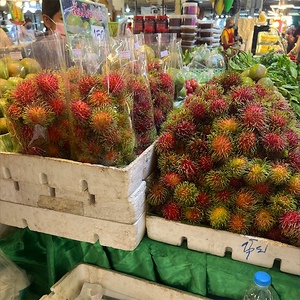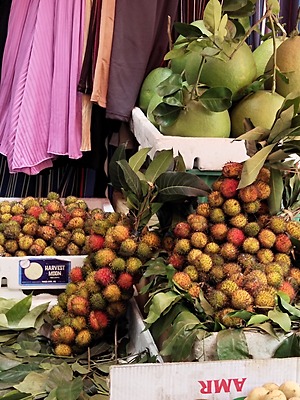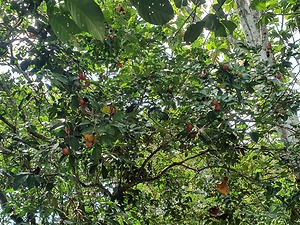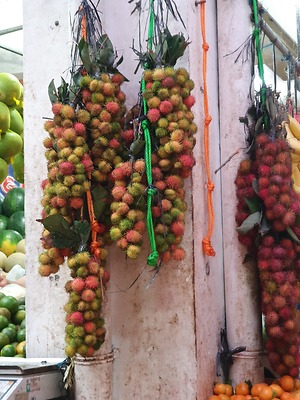


Aceh Pelat Rambutan
Estimated Inventory, lb : 0
Description/Taste
Aceh Pelat rambutans are small to medium in size, averaging 2-3 centimeters in diameter, and are round to ovate in shape growing in a loose cluster of 10-13 fruits. The rind is semi-thick, leathery, and firm, and is covered in soft, hair-like protrusions known as spinterns. These flexible spines are characteristically shorter than other rambutan varieties and are found tightly compacted around the rind in varying lengths. The rind also has a green, yellow, or orange base with red, pink, to yellow-green spinterns, often displaying many different colors on one fruit. Underneath the rind, the slightly dry flesh is translucent, soft, smooth, and is easily removed from the rind when peeled. In the center of the flesh, there is an oblong, light brown to cream-colored seed that is wrapped in layers of papery shell and is edible when cooked. Aceh Pelat rambutans have a slightly sticky consistency with a mild, sweet flavor.
Seasons/Availability
Aceh Pelat rambutans are available year-round in tropical climates, with a peak season in the winter in Southeast Asia.
Current Facts
Aceh Pelat rambutans, botanically classified as Nephelium lappaceum, are small fruits that grow on evergreen trees reaching up to twenty-five meters in height and belong to the Sapindaceae or soapberry family. Predominately found in both tropical lowlands and highlands, Aceh Pelat rambutan trees are high yielding, producing abundant clusters of fruit that can be sliced by hand from the tree. Also known as the Aceh Plate rambutan, Aceh Pelat rambutans are one of the most popular varieties in Southeast Asia, highly favored for its sweet flavor, and is sold in markets for fresh eating.
Nutritional Value
Aceh Pelat rambutans are a good source of vitamin C and also contain calcium, iron, and magnesium.
Applications
Aceh Pelat rambutans are best suited for raw applications as their sweet flavor is showcased when consumed fresh, out-of-hand. The rind can be sliced and opened with a knife or torn into by hand, and the flesh can be consumed whole, discarding the seed. The seed is edible, but it needs to be cooked before eating and can be roasted for a nutty flavor. Aceh Pelat rambutans are commonly consumed as a stand-alone snack, or they can be sliced into wedges and mixed into sorbets, ice creams, and fruit salads. They can also be incorporated into curries or soups or muddled into drinks. In addition to fresh applications, Aceh Pelat rambutans can be cooked and canned for extended use, stored in a simple syrup to top desserts, stuffed with spices, sauces, and herbs as an appetizer, or cooked into jellies and jams. Aceh Pelat rambutans pair well with kaffir lime leaves, turmeric, ginger, lemongrass, cilantro, peanuts, coconut milk, meats such as poultry, fish, or beef, tofu, and fruits such as coconut, kiwi, pineapple, and mango. The fruits will keep up to three days when stored at room temperature and up to six days when stored in a sealed container in the refrigerator.
Ethnic/Cultural Info
In Jakarta, Indonesia, the Betawi people were believed to have contributed to the naming the Aceh Pelat rambutan. Often growing rambutan trees on small plots of land for market resale, the Betawi people were familiar with the trees and commonly consumed the small, hairy fruits. When examining the fruit, a center line underneath the spinterns on the rind was discovered that resembled a plate-like shape. The fruit was then rumored to have been named by the Betawi after this flat shape. Today the fruit is also known by Aceh Plate and is commonly found in fresh markets and roadside stands when in season. Aceh Pelat rambutans are a popular variety for backyard gardens as the fruits are both ornamental and edible, and the trees can be grown in containers, pots, and small beds.
Geography/History
Aceh Pelat rambutans are believed to be native to the Malay Archipelago, specifically from the region of Pasar Minggu, which is a subdistrict of Jakarta, Indonesia. Today the fruit is mainly found in Southeast Asia at local markets, but it may also be found growing in home gardens and through specialty growers in Asia, Africa, Central America, and North America.



